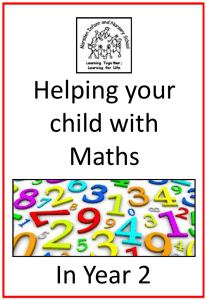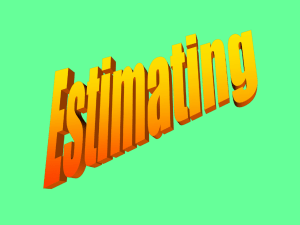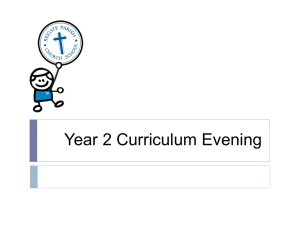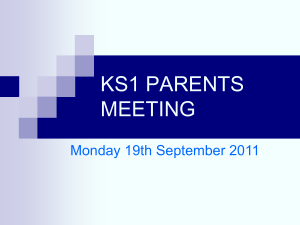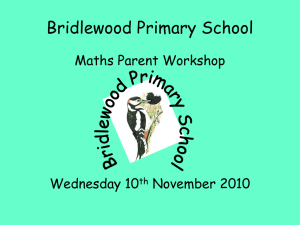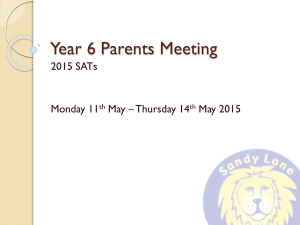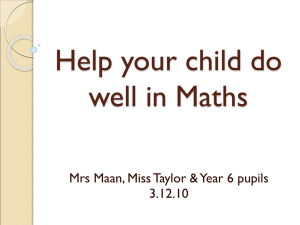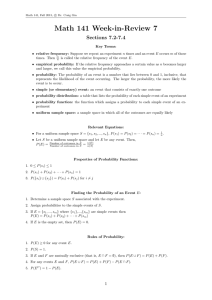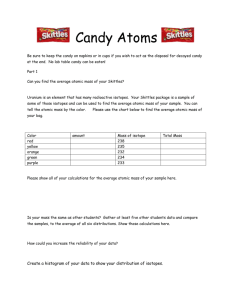Year 1
advertisement
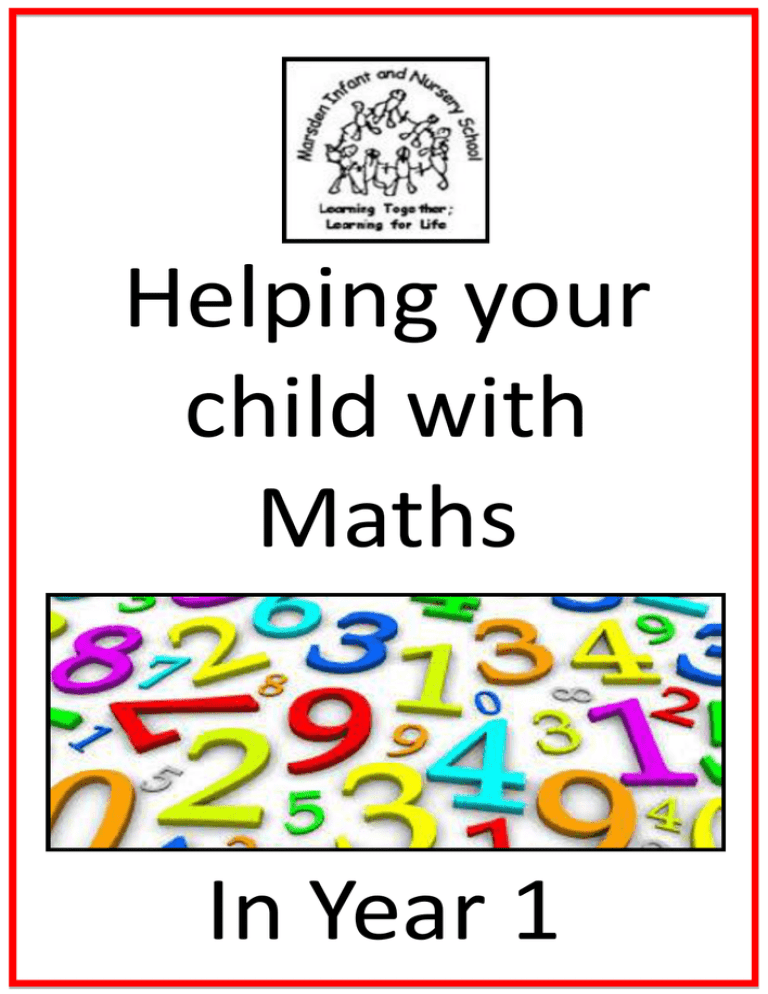
Helping your child with Maths In Year 1 Helping your child with Maths Try to make maths as much fun as possible - games, puzzles and jigsaws are a great way to start. It's also important to show how we use maths skills in our everyday lives and to involve your child in this. Don't shy away from maths if you didn’t like it at school. Try to find new ways to enjoy the subject with your child. Here are some ideas: Counting Help your child to count beyond 20 by counting steps as you walk to school. Try starting at a multiple of 10 (10, 20, 30, 40 etc.) and help your child to count on. You could also count steps in 2s, 5s or 10s to help your child learn these times tables. Children also need to be able to count backwards to help them with subtraction. Try starting at 20 and count backwards with each step you take. Once your child can confidently count back from 20, try bigger numbers to start from. Number Recognition Help your child to learn to recognise numbers. Point out numbers you see in everyday activities, such as numbers on packets or prices, car number plates, house or bus numbers. Number Formation Help your child practise writing numbers. Start with 1 to 9, focusing on getting the numbers the right way around. The numbers below have a dot to show you where to start and an arrow to show the direction to form the number in. Try asking your child to write the numbers in random order. Once your child can confidently write these numbers the correct way around, move to 10 and beyond. Addition Roll 2 dice/ pick 2 numbers out of a hat. Ask your child to put the bigger number first. Help them add the two numbers together by counting on. E.g. If you roll a 3 and a 6, put the 6 first. Encourage your child to put the number 6 in their head, then count on 3 more. So, they will say 6, and count on 7,8,9. Children often want to count all the spots. Emphasise that we don’t need to count the first 6, we can start from this number and count on. Once your child can add together 2 single digit numbers, move on to rolling 3 dice. Make a target game Place three or four empty boxes on the floor. Label each box with a number between 1 and 5. Encourage your child to help you to make up rules for the game. How many paper balls can you throw in a turn? How many does the winner of the game need to score altogether? Playing skittles Make a set of skittles using ten cardboard tubes which can be knocked over with a soft ball. Score 1 for every skittle knocked over. Move on to scoring 2 for every skittle knocked over and help your child count in 2s. Also try scoring 5 and 10 for every skittle. More advanced number work Make some 2 digit number cards. Ask your child to read the number. • How many tens are in the number? • How many units? • Can your child write the 2 digit number? • Ask your child to put the numbers in order, from smallest to biggest. 25 47 61 89 93 47 40 (4 tens) 7 (7 units) Other ideas as an alternative to number cards: Adding 10 Use the 100 square below to help your child to add 10 to a 2 digit number. Throw a counter onto the 100 square and ask your child to say what number it has landed on. Ask them to find the number which is 10 more. Encourage them to describe what has happened to the number (the number in the 10s column has got bigger by 1). Encourage your child to recognise the ‘quick’ way of adding 10. They do not need to count on 10, they can simply move to the number below the one they landed on. Once they understand this, they are ready to add a multiple of 10. (10/20/30/40/50/60/70/80/90.) Subtracting 10 You can use the 100 square to subtract 10 and multiples of 10. Ask your child to explain how they could subtract 10. Encourage them to recognise that they need to look at the number above the one they landed on. They can then move on to subtracting multiples of 10. Number Bonds to 10 Playing skittles Make a set of skittles using ten cardboard tubes which can be knocked over with a soft ball. After each throw talk about the score: There were ten skittles and we knocked over 6. There are 4 left standing up. 6 and 4 make 10. Number bond dice games Roll a die. Ask your child what number goes with the number rolled to make 10. 0 + 10 = 10 6 + 4 = 10 1 + 9 = 10 7 + 3 = 10 2 + 8 = 10 8 + 2 = 10 3 + 7 = 10 9 + 1 = 10 4 + 6 = 10 10 + 0 = 10 5 + 5 = 10 What we are aiming for is immediate recall of number bonds to 10. You could play the “I say, you say” game. You say a number below 10 and your child has to give you the number bond that goes with it to make 10, as quickly as possible. ( I say 4, you say ___). Your child says 6. Number Bonds to 20 Use a set of 20 objects to help your child learn number bonds to 20. Start with 10 + 10. Tell your child to move one counter over to the other side. How many are on each side now? 9 + 11. Challenge your child to find as many different ways to make 20 as possible, by adding 2 numbers together. 0 + 20 = 20 1 + 19 = 20 2 + 18 = 20 3 + 17 = 20 4 + 16 = 20 5 + 15 = 20 6 + 14 = 20 7 + 13 = 20 8 + 12 = 20 9 + 11 = 20 10 + 10 = 20 11 + 9 = 20 Subtraction Roll 2 dice. Ask your child to put the biggest number first, then subtract (take away) the smallest from the largest. Or you could write numbers (up to 10 at first) on pieces of paper and ask your child to pick 2, then subtract the smallest from the largest. Your child may like to use buttons as to help with subtraction. When your child is confident at working within 10, move on to 20 and beyond. More difficult Subtraction Choose a 2 digit number card and roll a dice. Write down the number sentence: 25 25 – 6 = 19 Encourage your child to put the bigger number in their head and count back. Remind your child that we don’t say the number we start on. So, for the above number sentence, your child would put 25 in their head and say 24, 23, 22, 21, 20, 19. Doubling Introduce your child to doubling numbers by using 2 sets of objects of the same size: Double 3 equals 6. 3 + 3 = 6. Start with numbers up to 5 and then progress to numbers up to 10. The aim is for your child to be able to recall doubles up to double 10 instantly. This requires lots of practice. Near doubles When your child can double numbers up to 10, move on to near doubles, e.g. 6 + 7. Double 7 is 14. We then need to subtract 1, because we are finding 6 + 7. Sharing Give your child some pebbles/buttons/grapes etc. and ask them to share them fairly between 2 teddies, so it is fair and both teddies get the same amount. When your child can share between 2 teddies, move on to sharing fairly between 3, 4 and then 5 teddies. 2D Shape Talk about the different shapes around the home and when you are out walking. (Circle/square/triangle/rectangle/pentagon/hexagon/octagon.) 3D Shape Ask your child what a 3D shape is. It is one which you can hold in your hand. 2D shapes are flat. Look for 3D shapes everywhere you go. You could take photographs and make a 3D shape book. The most common 3D shapes are shown below: cuboid cube cone sphere triangular prism cylinder Time In year 1 we focus on o’ clock and half past times. Once your child has mastered this, move on to quarter to the hour and quarter past the hour. Capacity Select 3 different size and shape containers – mugs/bottles/glasses etc. Ask your child which one they think holds the most water. Test this by seeing how many times you have to fill that container to fill a saucepan. You could record your results in a table. Container How many to fill the saucepan? Plastic beaker Tea cup Bottle Talk to your child about the shape of the containers. Did the tallest one hold the most water? Money When you go shopping there are many opportunities for helping your child with maths. Let them handle money and help them to recognise the coins. Ask your child to give you 6p. Ask your child if that is the only way to make 6p. What other ways are there? Once your child is used to investigating making 6p in different ways, move on to a bigger number. Change Give your child 20p. Set up a shop where everything costs less than 20p. Let your child ‘buy’ something from the shop and ask them how much change they need. Weight If you weigh foods when shopping or baking, share with your child how you read the scales. Encourage them to have a go at reading the scales for themselves. Useful Websites http://www.oxfordowl.co.uk/for-home/maths-owl/funactivities http://www.topmarks.co.uk/maths-games/5-7-years/counting http://www.bbc.co.uk/bitesize/ks1/maths/ http://www.ictgames.com/resources.html http://www.sumdog.com/en/parents/ http://www.theclassroomkit.com/numeral-recognitiongames.html http://primarygamesarena.com/Year-1 http://www.twinkl.co.uk/
